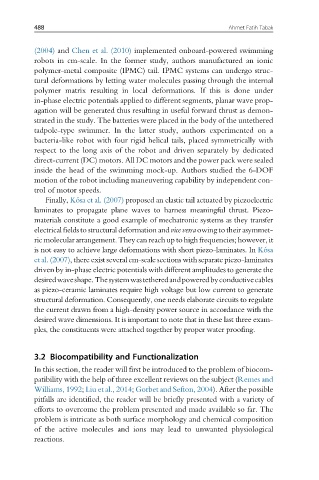Page 494 - Handbook of Biomechatronics
P. 494
488 Ahmet Fatih Tabak
(2004) and Chen et al. (2010) implemented onboard-powered swimming
robots in cm-scale. In the former study, authors manufactured an ionic
polymer-metal composite (IPMC) tail. IPMC systems can undergo struc-
tural deformations by letting water molecules passing through the internal
polymer matrix resulting in local deformations. If this is done under
in-phase electric potentials applied to different segments, planar wave prop-
agation will be generated thus resulting in useful forward thrust as demon-
strated in the study. The batteries were placed in the body of the untethered
tadpole-type swimmer. In the latter study, authors experimented on a
bacteria-like robot with four rigid helical tails, placed symmetrically with
respect to the long axis of the robot and driven separately by dedicated
direct-current (DC) motors. All DC motors and the power pack were sealed
inside the head of the swimming mock-up. Authors studied the 6-DOF
motion of the robot including maneuvering capability by independent con-
trol of motor speeds.
Finally, Ko ´sa et al. (2007) proposed an elastic tail actuated by piezoelectric
laminates to propagate plane waves to harness meaningful thrust. Piezo-
materials constitute a good example of mechatronic systems as they transfer
electrical fields to structural deformation and vice versa owing to their asymmet-
ric molecular arrangement. They can reachupto high frequencies; however, it
is not easy to achieve large deformations with short piezo-laminates. In Ko ´sa
et al. (2007), there exist several cm-scale sections with separate piezo-laminates
driven by in-phase electric potentials with different amplitudes to generate the
desiredwaveshape.Thesystemwastetheredandpoweredbyconductivecables
as piezo-ceramic laminates require high voltage but low current to generate
structural deformation. Consequently, one needs elaborate circuits to regulate
the current drawn from a high-density power source in accordance with the
desired wave dimensions. It is important to note that in these last three exam-
ples, the constituents were attached together by proper water proofing.
3.2 Biocompatibility and Functionalization
In this section, the reader will first be introduced to the problem of biocom-
patibility with the help of three excellent reviews on the subject (Remes and
Williams, 1992; Liu et al., 2014; Gorbet and Sefton, 2004). After the possible
pitfalls are identified, the reader will be briefly presented with a variety of
efforts to overcome the problem presented and made available so far. The
problem is intricate as both surface morphology and chemical composition
of the active molecules and ions may lead to unwanted physiological
reactions.

